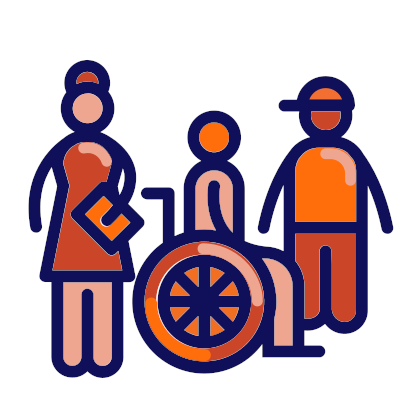Tackling discrimination

Schools can tackle discrimination by promoting democracy, respect for human rights and citizenship.
To ensure that all students’ needs are met equally, schools need to prioritise language and cultural competences, multiperspectivity in history and gender equality. In this way, students can acquire competences for democratic culture, to fulfil their potential in school as well as in society.
Facts & figures
Students with disabilities in Europe have higher early-school leaving-rates than their same-age peers.[1]
Black Caribbean students are three times more likely to be excluded from English schools than white pupils. [2]
A survey of nine EU countries showed that 33% of Roma students were in schools where most pupils were Roma, with 13% in Roma-only schools.[3]
What is discrimination?
Discrimination is treating a person badly or unfairly on account of a personal characteristic, such as national, ethnic or social origin, gender, language, religion, disability or sexual orientation.
There are two basic forms of discrimination:
- Direct discrimination – treating someone less favourably than you treat or would treat another person in the same situation, e.g., a school refusing to admit a student because they are Roma,
- Indirect discrimination – applying a provision, criterion or practice in the same way for all of a group which has the effect of unfairly disadvantaging people in the group who share a particular characteristic, e.g., a school uniform policy banning headgears for girls and boys may unfairly disadvantage Muslim girls and Jewish boys.
Discrimination can occur in almost any aspect of school life, from the attitudes and expectations of teachers to school rules and codes of conduct, selection and grouping practices, curricula, teaching methods and materials, changing facilities, career guidance, canteen food and the physical school environment.
Whatever form it takes – whether it be parallel school systems for different ethnic groups, concentrations of minority or disadvantaged children in the same school, or differential access to educational provision, it means a lower quality of educational experience for the students being discriminated against.
Why is tackling discrimination important at school?
Discrimination is a human rights violation. Article 14 of the European Convention on Human Rights contains a prohibition on discrimination with respect to any of the rights and freedoms guaranteed under the Convention. Article 2 of Protocol No.1 requires the state to ensure that all individuals have access to its formal educational provision.
“No person shall be denied the right to education.”[4]
“The enjoyment of the rights and freedoms set forth in this Convention shall be secured without discrimination on any ground such as sex, race, colour, language, religion, political or other opinion, national or social origin, association with a national minority, property, birth or other status.”[5]
Tackling discrimination is not simply a duty laid on schools by the European Convention of Human Rights, it is also important for student well-being and educational success. Children and young people who are treated unfairly or discriminated against are more likely to have:
- negative attitudes to school
- lower levels of motivation and academic achievement
- a higher risk of dropping out of formal education
- experience of bullying
- mental health problems.
Feeling different or ‘less’ than others can be an isolating experience. Over time it undermines an individual’s capacity for participation in society, e.g., their sense of self-efficacy, openness to other cultures and beliefs, tolerance of ambiguity and flexibility and adaptability - all of which lie at the heart of the Council of Europe Reference Framework of Competences for Democratic Culture.
Lack of opportunity due to discrimination in school also damages society. It intensifies social divisions, fuels xenophobia and intolerance and undermines social cohesion.
“States should adopt a combination of strong anti-discrimination measures and policies that promote more inclusive education systems where all children learn together. This is not a utopian project, but an achievable goal that can ensure more equal treatment of all children and, in the long term, improve social cohesion”[6]
What are the challenges?
One of the challenges facing the tackling of discrimination in schools is a lack of data. European-wide statistics specifically focused on discrimination in schools are scarce. Children with disabilities, for example, do not always appear in national statistics and may be ‘invisible’ to decision-makers, service providers and the public. Such children are particularly vulnerable to discrimination, however, and are often segregated in terms of educational provision.
These are not the only ‘invisible’ minorities in schools. For example, LGBTI students often feel they have to hide their sexual orientation at school to avoid victimisation.
Another key challenge is the existence of negative stereotypes about minority groups among teachers, parents, students and other school stakeholders. Such stereotypes are often deeply embedded in everyday school life and practice, so much so that they are taken as ‘normal’, e.g., stories and images in textbooks that reflect a stereotyped portrayal of the roles of women and men, girls and boys. Stereotypes help to fuel prejudiced and aggressive behaviour between students, lower expectations from teachers and negative attitudes from parents, e.g., refusing to allow their children to be taught alongside refugee or migrant children.
Stereotyping is difficult to root out in schools because its origins lie in wider society. This is exacerbated by the current preponderance of hate speech, fake news and conspiracy theories in digital media, especially social media.
The situation is compounded when minority groups are under-represented on school staff. Students lack role - models and teachers do not have the access to information about or insights into other cultures and ways of life that come with belonging to a more diverse profession. They lack the intercultural competences with which to create inclusive and quality learning environments, e.g., openness to cultural otherness, tolerance of ambiguity, plurilingual skills and knowledge and critical understanding of alternative cultures, religions and histories.
Tackling discrimination is more challenging when there is a lack of dialogue between schools and parents. Often this is on account of language difficulties, but it is also a problem where students’ parents work abroad leaving their children in the charge of elderly relatives or others.
How can schools get active?
Ensuring all learners of any age are provided with meaningful, high-quality educational opportunities alongside their peers requires a whole-school approach.
It begins by schools understanding who might be at risk of discrimination, what they can do to minimise discrimination and how they can support students at risk of discrimination. A good place to start is with an assessment of the current situation, identifying the strengths that exist in the school, but also needs and priorities. Consulting with school stakeholders is essential, especially students and, where possible, parents – e.g., using surveys, questionnaires, focus groups, etc. Given the sensitivities involved there is argument for collecting information on individuals’ experiences of discrimination anonymously.
Based on an assessment of the current situation it is possible to identify immediate priorities for policy development. Priorities will vary with the school, but might include, for example:
- language development
- gender equality
- accessibility of the physical environment
- intercultural competences.
The setting of initial priorities should go hand in hand with professional development for senior leadership teams as well as teaching staff. An element of personal as well as professional reflection is essential to the tackling of discrimination in school. In particular, it is important for school staff to be able to consider their own beliefs and values with regard to discrimination, including their own unconscious biases and prejudices.
Schools can then turn to the longer-term aspiration of creating a culture of non-discrimination. Central to this process is the challenging of negative stereotyping, both in classrooms and around the school. This can be done in a variety of ways, including:
- challenging stereotypes when they are heard
- discussing stereotypes with students
- identifying stereotypes in the curriculum
- highlighting stereotypical images and roles in textbooks
- allocating posts of responsibility equitably
- choosing different ways of dividing up students
- providing a range of role-models
- setting up mechanisms for monitoring incidents of discrimination.
Challenging stereotypes goes alongside the promotion of inclusion and an appreciation of the benefits of diversity in school life. This can take different forms, including:
- using inclusive language
- including human rights, democratic citizenship and intercultural education in the curriculum
- encouraging the discussion of controversial issues
- promoting student voice
- involving students in peer education and peer mediation activities
- welcoming parents and involving them in school decision-making
- forming partnerships with different organisations and groups in the community.
[1] Education section of the The European Disability Forum
[2] Article: UK: Racial discrimination is a reality in schools and classrooms. Education International
[3] EU Fundamental Rights Agency, “Second European Union Minorities and Discrimination Survey (EU-MIDIS II) Roma – Selected findings” (2017).
[4] ECHR, Article 2, Protocol No.1
[6] Position paper: Fighting school segregation in Europe through inclusive education by the Council of Europe Commissioner for Human Rights
 Resources on Tackling discrimination
Resources on Tackling discrimination
Address: Tsalenjikha,Gamsakhurdia str N1
Country: Georgia
Project: Democracy in the children’s hands
 Working language during the project:
Working language during the project:
- Georgian
- English
 Themes of the Council of Europe project “FREE to SPEAK, SAFE to LEARN - Democratic Schools for All” covered:
Themes of the Council of Europe project “FREE to SPEAK, SAFE to LEARN - Democratic Schools for All” covered:
- Making children’s and students’ voices heard
- Addressing controversial issues
- Improving well-being at school
 Competences from the Reference Framework of Competences for Democratic Culture (CDC) addressed and where / how they were integrated:
Competences from the Reference Framework of Competences for Democratic Culture (CDC) addressed and where / how they were integrated:
- Valuing democracy, justice, fairness, equality and the rule of law
Students understand the importance of learning about Democracy in school and becoming active citizens.
Students understand the importance of the Rule of Law and are capable of explaining why laws shall be implemented and enforced.
Students learn that elections should always be conducted democratically, in line with national and international standards.
(video watching, role play, discussion, creating brochures) - Knowledge and critical understanding of the world: politics, law, human rights, culture, cultures, religions, history, media, economies, environment, sustainability
Students learn about core political concepts, including Democracy, Freedom, Citizenship, Rights and responsibilities.
Students learn that Human Rights are universal and inalienable, and they understand it is the responsibility of everyone to respect them.
(video watching, discussion, presentations, creating election slogans, producing brochures with guidelines on school principal elections.) - Responsibility;
Students show that they take responsibility for their own actions and mistakes.
Students respect the deadlines for school assignments.
(debates, group role play, group presentations presented and reflected on in class, creating dioramas and making exhibitions at school)
 Target group age range:
Target group age range:
- 11-15
- 15-19
 Level of education:
Level of education:
- Lower secondary education
- Upper secondary education
Short description of the project:
The project developing democracy competences at school was a 3-month project held in March, April and May 2019. During the project, teachers planned and implemented formal education activities on the following topics: human rights, equality, democracy – achievements and challenges. Project activities aimed to investigate children's views and experiences of democracy and pupil participation in relation to everyday school life, and to let their voices be heard on the following issues: respect, empathy, responsibility, cultural diversity, civic mindedness, and tolerance. Finally, the project served to foster a democratic culture at school. This project brings to gather students from different countries.
Approximately 15 teachers from the primary school and lower secondary school and 250 students participated in it. Teachers planned the activities in groups, discussed the challenges that could arise and worked on recommendations for successfully implementing the project. Teachers were on the lookout for best practices and shared their experiences with their colleagues. The project was beneficial not only for students, but also for teachers and for the school, as it served to build a positive school culture and democracy at school.
The first activity was implemented by the lower secondary school students (class 8-9)
Topic: Valuing democracy, justice, fairness, equality and the rule of the law;
Objectives: to teach students that democratic elections should always be conducted honestly, in a free and fair environment, in accordance with international standards and national law, raise awareness of students about the importance of democracy at school.
Steps: video watching, role play, discussion, creating brochures including recommendations on how to imitate the elections at school. The students received recommendations from the members of Tsalenjikha District Election Commission.
Student in Tsalenjikha District Commission
The second activity was implemented by the upper secondary school students (class 10-12)
Topic: Knowledge and critical understanding of the world: politics, law, human rights, culture, cultures, religions, history, media, economies, environment, sustainability ;
Objectives: to understand the meaning of law, human rights, media, to understand the difference between basic political concepts, including democracy, freedom, citizenship, rights and duties.
Steps: video watching, discussion, presentations, creating election slogans, producing brochures with guidelines on school principal election.
May- Day of governance. In an election, students elected a 10th grade student as a school principal.
Democracy in the children's hands
Election Day
Election Day at School
The third activity was implemented by the lower and upper secondary school students (class 8-12).
Topic: Responsibility; Human rights / Children’s rights
Objectives: to express willingness to take responsibility for their own actions.
Help students to find their self-confidence, to know how to deal with unforeseen situations with their own resources , to understand the meaning of human rights and children’s rights; raise students’ awareness of the importance of human rights protection; make recommendations on human rights protection; develop cooperation and communication skills.
Steps: debates, group role play, group presentations presented and reflected on in class, creating dioramas and making exhibitions at school. The school was transferred to the control of the students. For a week the students performed their duties while the school principal and teachers were in the role of students.
The school is in the students' hands
 Aims/objectives
Aims/objectives
- To create a positive environment at school;
- To increase the motivation of teachers and students;
- To build a student-centred environment;
- To develop democratic competences at school.
 Expected results/outcomes
Expected results/outcomes
As the result of this project, about 250 students from the primary and lower secondary schools:
- Developed critical and analytical skills;
- Developed observation and empathy skills;
- Developed flexibility and adaptability skills;
- Developed communication and conflict resolution skills;
- Were made aware of cultural diversity and human rights;
- Became more tolerant and responsible;
- Gained knowledge of other related issues.
- Filmed 5 videos on democratic values and made 3 thematical posters.
 Changes
Changes
- The dates of certain activities.
- Improvement in relations between teachers and students as they work together on problem solving.
- Communication with the community within the project.
 Challenges you faced
Challenges you faced
- When selecting a candidate for the classes, many students expressed a desire to be included in the list of winning candidates.
- When the school moved to student management, many students expressed a desire to adapt to the role of teacher.
- How to persuade ourselves – the teachers - to stand behind and give more space to the pupils.
 Time-frame of the project:
Time-frame of the project:
12.03.2019–30.05.2019
 Council of Europe materials on citizenship and human rights education used while preparing or implementing your practice:
Council of Europe materials on citizenship and human rights education used while preparing or implementing your practice:
- Reference Framework of Competences for Democratic Culture
- Democratic governance of schools
- Human Rights and Democracy Start with Us – Charter for All
- Freedom(s) - Learning activities for secondary schools on the case law of the European Court of Human Rights
- How all Teachers Can Support EDC/HRE: A Framework for the Development of Competences
- Multimedia Material (ex. video “Beat Bullying”, series of cartoons “Democracy and Human Rights at School”, video “Corporal punishment at school: how two parents decided to change things”)
 Related schools projects
Related schools projects
Bosnia and Herzegovina
Bulgaria
Cyprus
Finland
France
Georgia
Germany
Greece
Ireland
Italy
Lithuania
Malta
Montenegro
Norway
Portugal
Republic of Moldova
Romania
Serbia
Slovenia
Spain
Turkey
United Kingdom







